It’s no secret that most salvia species are great nectar plants for butterflies and hummingbirds. One of my favorites is pineapple sage (Salvia elegans). It is perfect for cool-season butterfly gardens in zones 8 to 11 because it only blooms as days grow short and nights grow long. In its native Mexico, pineapple sage begins blooming in August. But further north it may not bloom until September or later. Once it gets going, though, it blooms straight through until spring, unless killed to the ground by a hard freeze.
Butterflies and hummingbirds are drawn to the colorful nectar-rich flowers. In Mexico, it’s been noted as one of the three most popular hummingbird plants! People also love this sage for the sweetly-scented foliage. The crushed leaf really does smell and even taste like pineapple, and it’s great in salads or teas.
Editor’s note: If you want to eat pineapple sage leaves, do not use pesticides or other chemicals in the garden.
Learn more about edible flowers: What flowers can you eat?

How to Grow Pineapple Sage
- Salvia elegens
- Zones 8-11 or annual
- Full sun
Pineapple sage is rarely grown from seed, so either buy it as a plant or start it from tip cuttings from a friend in the spring. One plant will spread, and can be divided over the years as well. Grow it in full sun to part shade and water it well during dry periods. Treat it as a perennial in zones 8 to 11 (it will come back from the roots after a freeze), or grow it as an annual in lower zones.
Try Rockin’ Golden Delicious pineapple sage for a golden garden glow. Place pineapple sage in full sun to achieve the maximum gold coloration; leaves stay more chartreuse in part shade. Bright red blooms appear in late summer, just in time to feed your butterflies and migrating hummingbirds.
The hummingbird traffic at this late bloomer is incredible, and so is the size it reaches in a single season—up to 3 feet tall and wide! But growing it is a bit of a gamble. If frost comes before it reaches full fiery bloom, it could kill the plant. To extend its life be sure to throw a bed sheet over pineapple sage when frost is forecast.
What Does a Hairy Woodpecker Look Like?
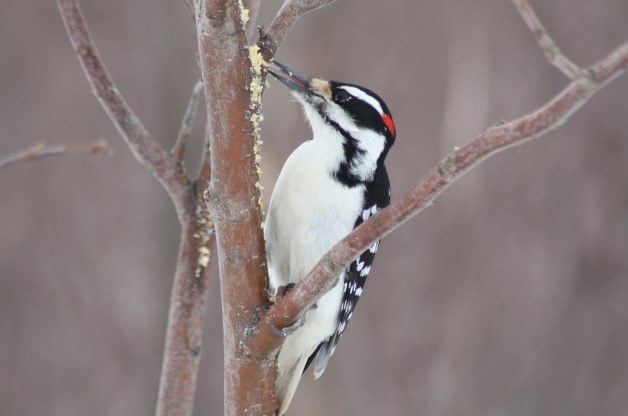
A hairy woodpecker is black and white with a spotted back and wings and white underparts. The birds are 9-1/4 inches long, with a 15 inch wingspan. While its markings are similar to the downy woodpecker, the hairy is about one-third larger, close to the size of a robin. Its chisel-shaped bill is prominent, about the same length as its head. Its coloring varies across North America, and at times it appears to be stained with brown watercolors and has less spotting.
Check out 10 woodpecker species birders should know.
Female Hairy Woodpecker
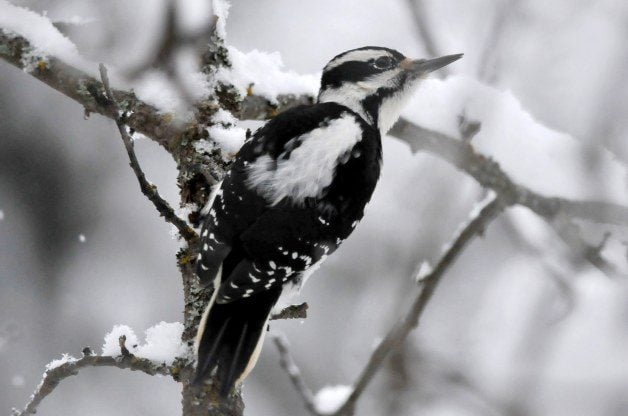
The female lacks the red patch on the back of its head. Psst—here’s how to identify a red headed woodpecker.
Nest and Eggs
Hairy woodpeckers nest in a cavity excavated by both sexes. The female usually lays four white eggs. Learn all about red bellied woodpeckers.
Juvenile Hairy Woodpecker
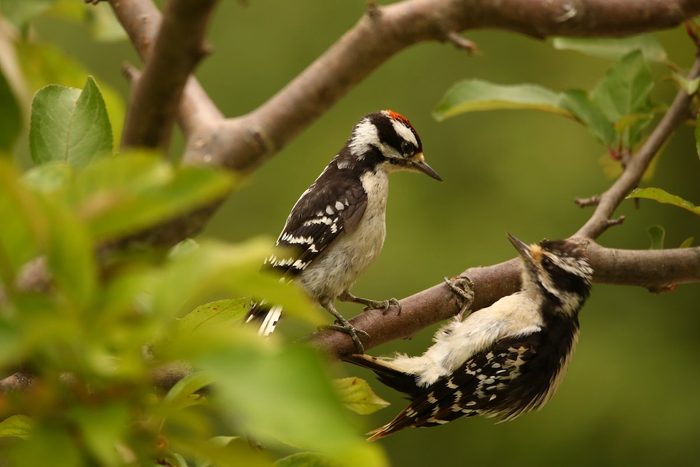
An immature hairy may show some brown in its feathers. On a very young bird, look for the loose, fluffy feathers of a fledgling.
Hairy Woodpecker Call
Listen to hear what hairy woodpeckers sound like. Their call is a strong “peek” or “peech,” that sounds sharper than the downy.
Bird songs provided by the Cornell Lab of Ornithology.
Learn about the northern flicker: unique, beautiful woodpeckers.
What Do Hairy Woodpeckers Eat?

Their diet mainly consists of insects, larvae of woodborers, fruit and nuts. Attract hairy woodpeckers with feeders full of suet, peanuts, peanut butter and black-oil sunflower seeds, especially in the winter. Check out the 4 best foods for attracting woodpeckers.
Range Map and Habitat
These birds prefer forests, but may move to open country in fall and winter. You can see them year-round throughout much of the United States.
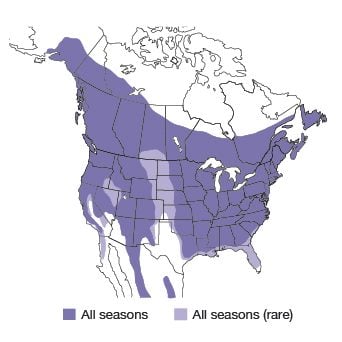
Range maps provided by Kaufman Field Guides, the official field guide of Birds & Blooms.
Next, learn why woodpeckers peck and how to stop it.
Some of us may not have the greenest of thumbs, but don’t let that stop you from enjoying all the benefits of houseplants. Not only are there plenty of low-maintenance houseplants to grow, houseplants add living beauty to your space and help purify the air, giving you a boost in both body and spirit. (Though do keep in mind that some houseplants are toxic to pets or children, so check aspca.org or children’s health websites before incorporating houseplants into your home.) These hard to kill houseplants will flourish under the care of beginners and even the most forgetful gardeners.

1. Philodendron
Add a subtle touch of burgundy or golden yellow to your living space with the wide, waxy leaves of philodendron. Try the varieties McColley’s Finale or Prince of Orange for colorful philodendron that are low-fuss. This houseplant can grow quickly, though, so keep it well groomed by trimming it back, staking upright types or winding the foliage around itself.
Why we love it: There are two types of philodendron: vining and non-climbing, so it’s a cinch to pick the type that best suits your space. It also accents other plants wonderfully.

2. Geranium
A reliable and eager bloomer, even in winter, geraniums come in every shade of the rainbow, and then some. If you want to add more than just color to your living space, explore the world of scented-leaf geraniums, which come in fragrances like pine, peppermint, and nutmeg.
Why we love it: Geraniums are hard to kill houseplants that are best left to their own devices. Water thoroughly, but only as needed, then sit back and enjoy the show.

3. Hens and Chicks
Whether it’s a single blooming sempervivum or a whole container of these rosette-shaped succulents, they make for an impressive presentation. These tough little guys need bright light to survive, and just one of these plants will easily propagate many more. This succulent’s only weakness is mealybugs, which can spread to other plants in your home if you’re not careful.
Why we love it: No matter where or how you plant it, hens and chicks will always look orderly and snug in their containers.
Check out the best indoor office plants for a home workspace (or cubicle).

4. Aloe
Want the look of an agave plant on a much smaller scale? Try family-friendly aloe. This funky-looking succulent flourishes in south-facing windowsills where they can get plenty of bright light, but east- and west-facing windows work just as well. Aloe loves company—cluster a few different varieties together in one container for a unique look.
Why we love it: The popular aloe vera doesn’t just look good—it’ll make you feel good, too. The jelly-like pulp inside its leaves is a great home remedy for minor burns and insect bites.
Discover the perfect houseplant for you, based on your zodiac sign.
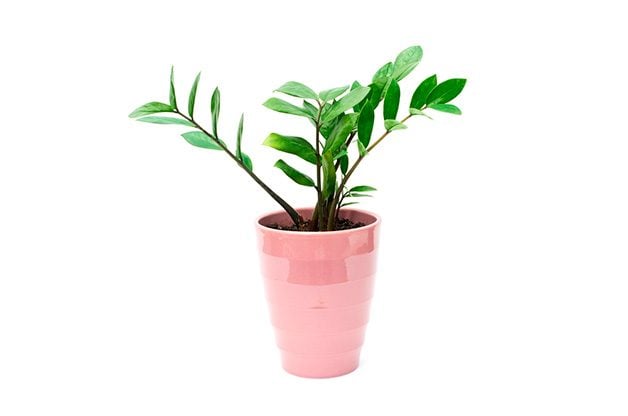
5. ZZ Plant
With no blooms when grown indoors and a slow growth-rate, ZZ plant doesn’t have a lot of frills. But what it lacks in pop, it makes up in polish with its glossy green leaves and vertical, palm-like stems. Splurge a little and buy a mature ZZ plant at the outset and give this slender statement plant its best chance to thrive in the indirect light of an east- or west-facing window.
Why we love it: ZZ plant works with every decorating style, because it looks awesome in any kind of container from a woven basket for a bohemian look to a chic glazed container for a modern space.
We found the top 10 dorm room plants for college students.
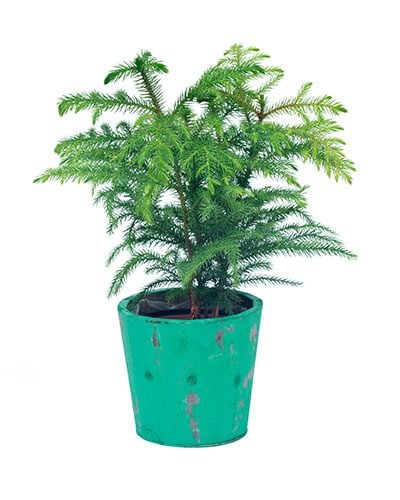
6. Norfolk Island Pine
Create an evergreen forest in miniature with a few Norfolk Island pines. The soft, feathery needles make this live tree friendlier than most. It’ll eventually become a small tree, but slow the growth process a little bit by keeping it tightly potted. Grow it in bright light and keep the soil moist.
Why we love it: Although unable to hold heavier ornaments, Norfolk Island pine can pull double-duty as a Christmas tree. Think cute, homemade popcorn chains, origami, and garland!
Learn why plants are perfect housewarming gifts (and 5 great ones to give!)

7. Thanksgiving Cactus
There are very few plants that prompt warm, fuzzy feelings of holiday nostalgia like the Thanksgiving cactus. This cactus bursts into beautiful bloom in midwinter, and its plump flowers come in a range of colors. For the best performance, don’t fuss and fret over Thanksgiving cactus beyond watering it when its soil is dry.
Why we love it: This cactus asks for next to nothing from its caretaker and will readily live on for years and years. These hard to kill houseplants also make a thoughtful holiday gift!
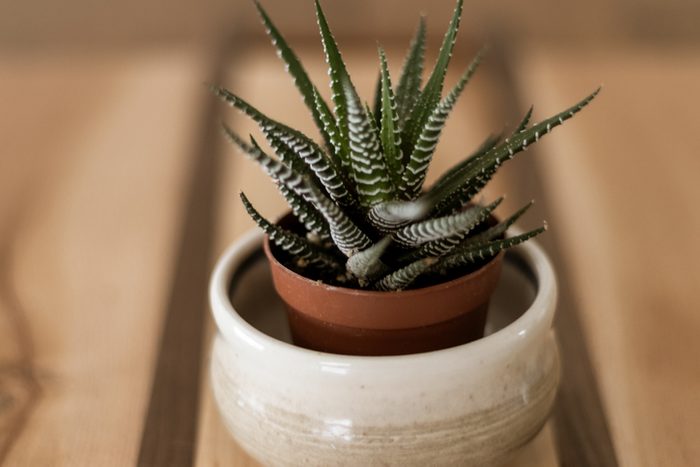
8. Haworthia
It’s easy to guess why haworthia is sometimes referred to as the zebra plant—the white, stripey bumps along its leaves make it stand out in a crowd. Not only is this houseplant eye-catching, it also withstands nearly any abuse thrown at it, since it doesn’t require much watering and does fine in most light conditions, though a south-facing window is best practice.
Why we love it: Haworthia has a long history—it was first referenced in writing in the early 1600s when European explorers brought haworthia back from southern Africa.
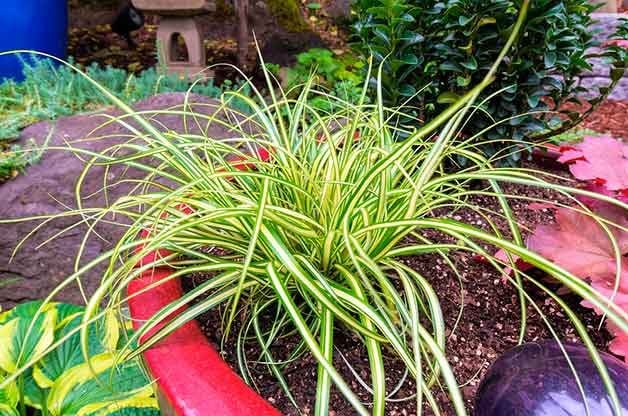
9. Carex
There are thousands of species of carex and they come in all shapes and sizes, but you really can’t go wrong with any of them. You’ll enjoy their elegant bursts of sweeping grass-like blades. If planting a larger variety, like Ice Ballet (C. morrowii), you’ll eventually need a hefty container, but always start with a pot one size bigger than it is currently growing in to prevent root rot.
Why we love it: If you have a habit of overwatering plants, carex is more tolerant of accidental soakings than most houseplants.
Check out the top 10 houseplants for low light.
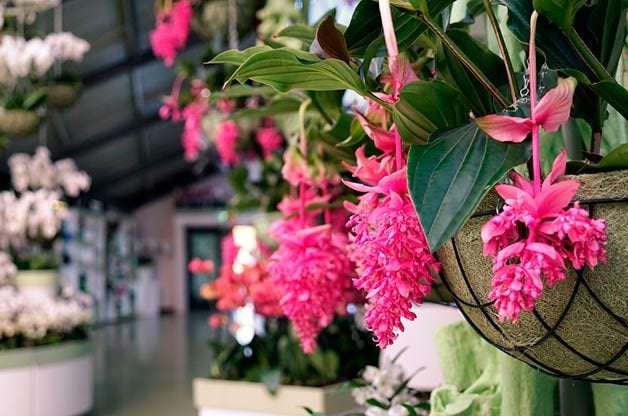
10. Medinilla
Put a medinilla in a room and it will demand your attention with its broad green leaves and pink-then-purple blooms. Give this showstopper houseplant the spotlight it deserves with a heavy container and a south-facing window, then watch as it slowly grows to the size of a small citrus tree (depending on variety).
Why we love it: Medinilla cheers up any room with its bright pink flower clusters during the doldrums of autumn and winter.
Check out these perfect gifts for plant lovers.
Growing Tips for Hard to Kill Houseplants
If you’re interested in dipping your toes a little further into the world of houseplants, we recommend the book The Indestructible Houseplant: 200 Beautiful Plants That Everyone Can Grow by Tovah Martin. Her book is packed with gorgeous photos and easy-to-follow suggestions for growing hard to kill houseplants. Here are her three tips for getting started with houseplants:
Create an environment checklist
How big are your windows and which direction do they face? Do you have a windowsill or furniture that can display your new houseplants? “Consider your space and think about how a little nature might improve the atmosphere,” Tovah says.
Look for houseplants at your local grocery or garden store
Don’t be turned off by potential houseplants that need a little love. Tovah says, “Any plant can become a supermodel when you work up its finer points, and the whole room will be the lucky beneficiary.”
Think about the container
“Go for a creative container that demands a second glance,” Tovah suggests. She has used pots and pans, hollowed tree stumps and colanders, but no matter what you use, be sure there are drainage holes. “Your first consideration should be practical,” she adds.
The seasons are changing. And if you’re like me, that means you’ll be out birding, looking for all the cool migrants that will be passing through. I’ll for sure be enjoying some group walks at my local nature center or at least visiting local parks where there will no doubt be other bird-watchers around. When you find yourself out birding in the field with others, there are a few basic birding etiquette tips you should follow.
Here are a few I came up with!
1. Do Put Your Cell Phone Away
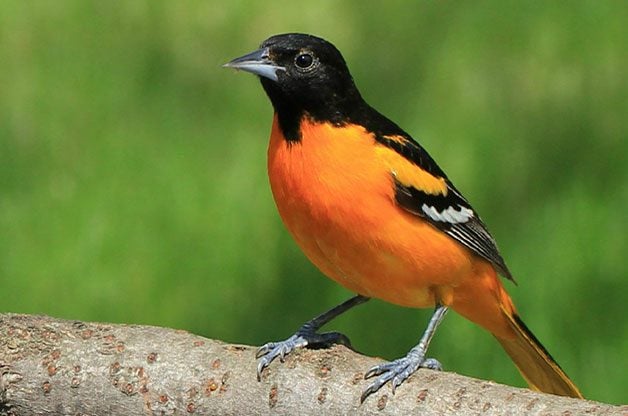
Let me preface this by saying that I’m what I like to call a “Google birder.” If I’m not sure what a bird is, I do a quick Google image search on my iPhone. Things like that are OK. What I mean by this one is don’t be the person checking your email or texting your friends while you’re on a group bird walk. You’ll appear uninterested and quite frankly, you’ll be missing out on the birds!
Check out 5 birding apps to give your skills a boost.
2. Don’t Forget You’re in the Birds’ Habitat
You’re entering their turf–where these birds eat, sleep, nest. Stay on the designated trails, don’t get too close and don’t do anything that will spook them.
To see more birds, go bird-watching in different bird habitats.
3. Do Enjoy Common Birds

Northern cardinals are gorgeous. Just ask my mom. It’s the only bird she seems interested in. Don’t forget to stop and enjoy cardinals, robins and goldfinches, too, even though you might see them every day.
Here’s 15 common backyard birds you should know.
4. Don’t Be Afraid to Eat a Snack
I’m the kind of person that needs to eat every two hours. So on my first ever half day birding trip, I immediately thought, “When are we going to eat?!” Rest assured. You’re out there for four or six hours at a time. By all means, eat that granola bar you packed. Just stuff the wrapper back in your bag.
Check out the best bird field guides for birders.
5. Do Speak up if You’re Not Getting an Eye on Birds
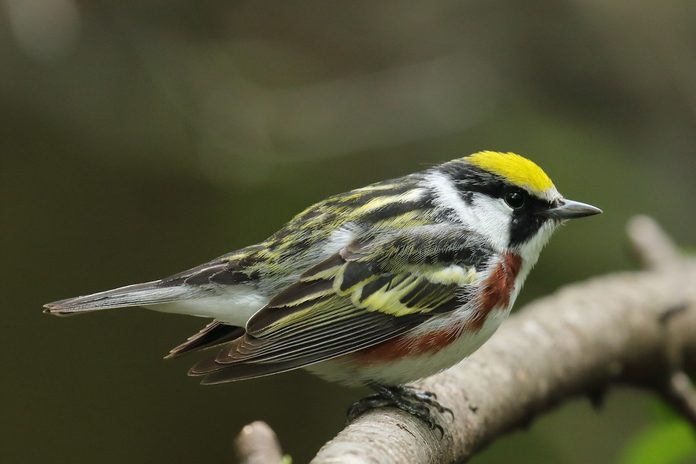
You know when everyone in your group is excited about that chestnut-sided warbler that is seemingly right in front of you and you just don’t see it? It can be a little embarrassing to then raise your hand and declare you have no idea what their excitement is about. But do it. Speak up. Someone will help you get your eyes on that cool bird.
Check out more spring warblers you should know.
6. Do Learn “Bird Directions.”
Unfortunately in the bird world saying things like “Right there!” in response to “Where’s the bird?” just won’t cut it. Not everyone is skilled at giving “bird directions,” but trying to accurately describe where the bird is will help everyone around you.
Psst—you can go birding in the city: Here’s how to be an urban birder.
7. Do Point Birds Out Even if You Don’t Know What They Are
If you’ve got your eye on something, let others know. There’s no shame in simply saying, “I see a bird with a white eye ring.” Then use those handy dandy bird directions from above to get others to see your bird. Then you can ID it together.
Learn how to identify mystery birds.
8. Don’t Worry About Calling Out the Wrong Bird
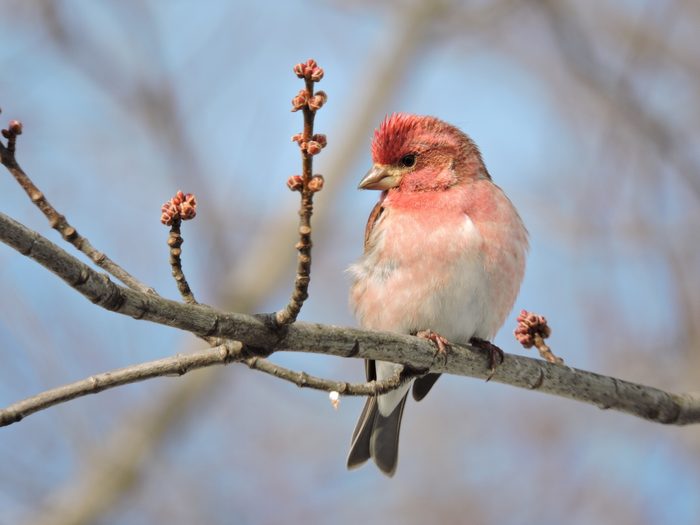
I admit that this is still a great fear of mine. I can’t tell you how many times I’ve seen a purple finch and confidently declared that I’m looking at some type of sparrow. The good news? Being wrong is a learning opportunity. Take the time to figure out what characteristics are throwing you off and chances are, you won’t make that mistake again.
Discover more ways to be a better birder.
9. Don’t Be Scared to Ask Questions
This is mostly relevant when you’re on a guided bird walk. Squeeze as much knowledge out of your guides as you can. If you’re a beginner, ask them about ID tips and tricks and the songs you’re hearing.
Learn how to buy binoculars with our birding binoculars guide.
10. Do Have Fun!
If you’ve never gone on a guided bird walk or participated in bird events in your area, I encourage you to do so. You learn so much from fellow birders. I promise that birding is more fun with friends!
Next, make your month-by-month birding resolutions.
As winter approaches, many backyard birders will offer suet to help their birds survive the colder months. Suet is a great source of fat for the birds and it helps them quickly refuel after cold nights when they’ve used all their energy trying to stay warm. When you’re picking out the perfect suet feeder for your yard, there are a few things that you should keep in mind.
A basic square cage feeder will attract some birds. But there are better options that might help you convince more birds, especially woodpeckers, to stick around longer.
Recycled Double Cake Suet Feeder

I prefer to use a feeder with a long tail prop and the birds seem to prefer it as well. The tail prop allows larger woodpeckers to be more comfortable on the feeder. Pileated woodpeckers and red-bellied woodpeckers are quite large and can have trouble staying on small feeders. This 2-cake suet feeder from Amazon features an extra long tail prop.
Check out the best feeding tips for fall birds.
If you have trouble with squirrels and bully birds, consider an upside-down suet feeder. This type of feeder keeps less agile birds like starlings, grackles and blackbirds off while giving woodpeckers and other clinging birds, like nuthatches, access to the suet from below. As an added deterrent, use hot pepper suet. The birds can’t taste it but the squirrels do not like it at all.
Field editor Ken Orich tested this feeder for Birds & Blooms. “I immediately liked it and could see the value in its design. House sparrows and European starlings clean out my suet feeders in a matter of days, leaving nothing for nuthatches, woodpeckers and chickadees. This feeder solves that problem,” he says. “A male downy woodpecker visited the Nature’s Way feeder for the first time less than two days after I hung it up.”
Ken added, “While I like the easy-to-remove roof (or lid) for inserting suet cakes, I found the interior measurements to be a bit tight for inserting store-bought suet cakes. When I pushed the cake in, pieces would break off, leaving a bit of a mess.” However, he also says the feeder is easy to clean.
Check out homemade suet recipes for feeding birds.
Cedar Double Suet Feeder
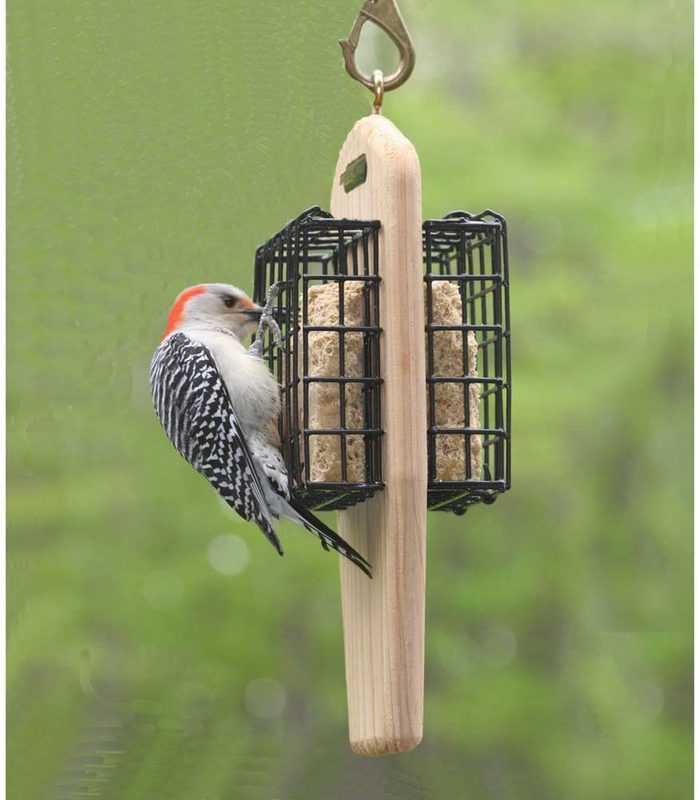
Designed specifically to give woodpeckers a place to prop their tails, with suet cakes on both sides, this cedar wood feeder makes for a stunning viewing station.
Learn how to tell the difference: downy vs hairy woodpeckers.
Suet Buffet Bird Feeder

The shingle-patterned roof on the buffet feeder keeps up to four suet cakes dry, and the grid design allows clinging birds to easily grab a bite to eat.
Check out large capacity bird feeders to feed a crowd.
Kettle Moraine Log Feeder
Consider a log feeder. Birds seem to love these and they are so easy to use. These logs come with holes drilled through them and you just push in suet plugs. The birds seem to love the natural feel of the log. You can also make these feeders yourself very easily!
Psst—these are the 10 types of bird feeders you need in your backyard.
Window Suet Feeder
Try a window suet feeder for a close-up view of your favorite birds. The suet cage attaches firmly to the glass with strong suction cups.
Next, discover the 4 best foods for attracting woodpeckers.
Summer is peak butterfly season with warm, sunny weather that sends colorful sulphurs, monarchs and swallowtails flitting through our gardens. But you might be surprised to know that there’s some significant butterfly activity in every season. Take a look at what you might expect to see throughout the year.
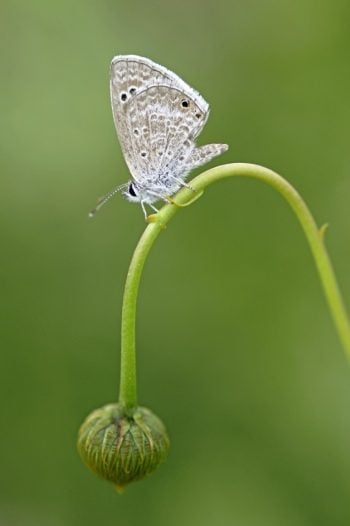
Spring: When Do Butterflies Come Out?
In the southernmost U.S., winter fades almost imperceptibly into spring. Elsewhere, however, particular species are sure signs of springtime. Among these are small white butterflies like West Virginia and spring whites, and various types of orangetips and marbles. Their caterpillars feed on wild plants in the mustard family, which grow mainly in spring. The adult butterflies must emerge early so females can lay eggs and the caterpillars can feed while the plants are available.
Other spring specialties include certain tiny blue butterflies, like the spring azure and the silvery blue. These little gems may show up in gardens or gather by the dozens around the edges of mud puddles. Less noticeable are some small, dark hairstreaks and skippers – somewhat obscure, but worth seeking out for their poetic names, like frosted elfin and sleepy duskywing. But no one is likely to overlook some of the big swallowtails that start flying early in the season, such as the gorgeous streamer-winged zebra swallowtail.
Look for a mourning cloak butterfly in early spring.
Early in spring, monarchs that have wintered in Mexico begin to move north. A few others—red admirals, painted ladies and American ladies among them—are on the move, too. In the Southwest, tens of thousands of painted ladies may join in a mass flight, flooding into gardens along their path. Week by week, new nonmigratory species emerge. Bright sulphurs, subtle satyrs, flashy fritillaries and others add to the color palette that will grace summer gardens.
Check out beautiful butterfly pictures you HAVE to see.

Summer: Butterfly Season at Its Peak
A large and diverse garden is often alive with butterflies all summer long. Casual observers may think they’re seeing the same ones over and over, but the reality is more complicated and more interesting. Most adult butterflies live two to three weeks at most. With common small species like pearl crescents and tailed blues, the first females to emerge in spring or early summer lay eggs that will soon hatch. The caterpillars will grow rapidly and pupate, and another batch of adults will appear; there may be three or more generations in the warm months.
Shorter summers often mean fewer generations. Several species, including some of the swallowtails, may have several broods a year in the Deep South but only one in the North. And some, including the great spangled fritillary, have a single generation each year regardless of latitude. Of course, the summer butterfly season is also when many migratory southern species push northward. Tropical sulphurs and skippers fly from Mexico into the American Southwest; widespread butterflies like buckeyes and red admirals may reach up beyond the Great Lakes. By summer’s end, migratory monarchs have reached the northern U.S. and far into Canada, poised for the temperature drop that will send them drifting south again.
In Alaska and Arctic Canada, a few butterflies – mostly lesser fritillaries and satyrs – fly only every other year. Summers are so short that the caterpillars hatch in one season, hibernate through one winter, feed and grow through the following summer, and then hibernate through a second winter before pupating and emerging as adults in their second summer. That’s why a species can be common one summer and seemingly absent the next.
Follow the stages of the monarch butterfly life cycle.
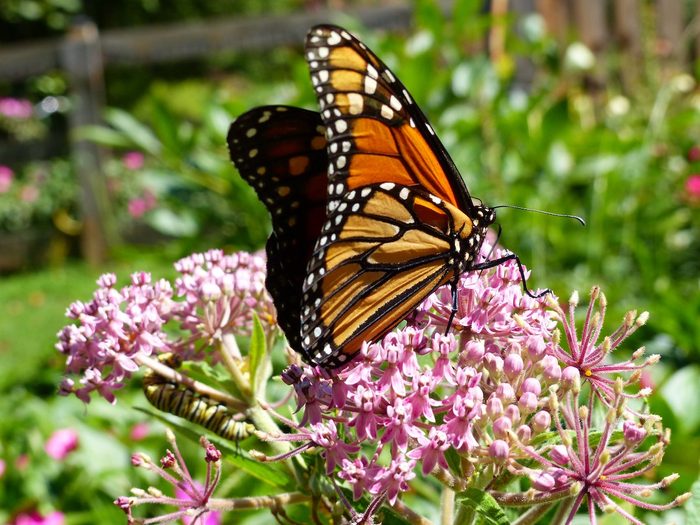
Fall: Butterfly Season is Winding Down
Most adult butterflies will perish before winter arrives. Long before the intense cold sets in, the females will have laid eggs, ensuring a new generation for the next year. With that taken care of, the adults may spend the rest of their short lives wandering in a seemingly aimless way.
But some species do live through the winter, hibernating in sheltered sites, and they may be seeking out these roosting spots as fall advances. Mourning cloaks, question marks, commas and tortoiseshells are among these hibernators, so if you see them flitting about woodpiles or tree cavities in fall, they are likely looking for winter shelter.
A few varieties fly only in late summer and fall. The red-bordered satyr, which makes its rather floppy way through Southwestern canyons in September, is one; another is Leonard’s skipper, a denizen of Northeastern meadows. Few of these show up in gardens, however; most of what you’ll see in your backyard is a continuation of summer habits, like the northern push of southern species. Subtropical creatures like big pale cloudless sulphurs and tiny orange fiery skippers may still be heading north in early October, even filtering into southern Canada.
Plant these late-blooming fall flowers that attract butterflies.
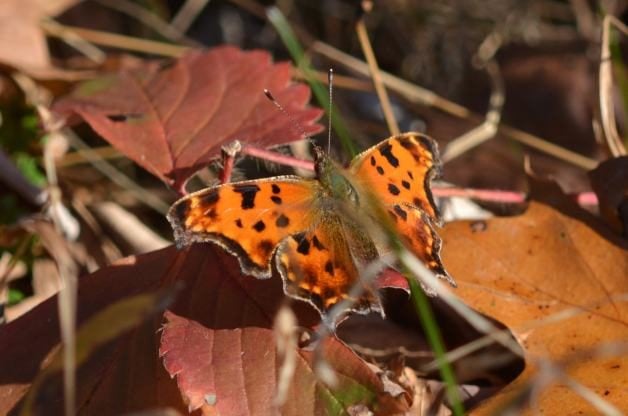
Winter: Hiding Out
Along the Gulf of Mexico, in the lowlands of the desert Southwest and on California’s coast, mild winters allow some butterflies to keep flying. They may be out of sight on cool, cloudy days, but red admirals, painted ladies and others fly in warmth. East of the Rockies, most monarchs are absent, having flown to Mexico. But much of the Western population spends the season in coastal California. They are sedentary, hanging in dense clusters in tall trees. On warm days, they’ll scatter to the wind like orange confetti, drifting back to the roost as evening nears.
Relatively few other species migrate, surviving the cold months in any of their four major life stages. A few tough butterflies hibernate as adults; a February thaw may wake them, producing the startling sight of a mourning cloak, comma or tortoiseshell flying over snowdrifts. Some swallowtails and others spend the winter as pupae, ready to emerge as adults in spring. Still others overwinter in the egg stage. Caterpillars might seem more vulnerable, but the majority of our butterflies spend the winter in that form. They may even hatch out of the egg in fall and not begin to eat until spring. So even when northern regions are locked in ice and snow, next summer’s butterflies take the shape of myriad tiny caterpillars sleeping in the cold.
Learn how to make a DIY butterfly puddler.
Year-Round Tips for Identifying Butterflies
Grab a field guide and ask yourself these questions when you see an unfamiliar butterfly.
- SIZE: How many inches is the wingspan?
- SHAPE: Is there a tail? Are the wings jagged or scalloped?
- POSTURE: How is it sitting? Wings folded up tight, spread wide, or half open in a V shape?
- FLIGHT STYLE: Is it flying with steady flaps, a quick flutter or completely erratically?
- FIELD MARKS: Is there a spot of color?
On This Page
What Does a Downy Woodpecker Look Like?
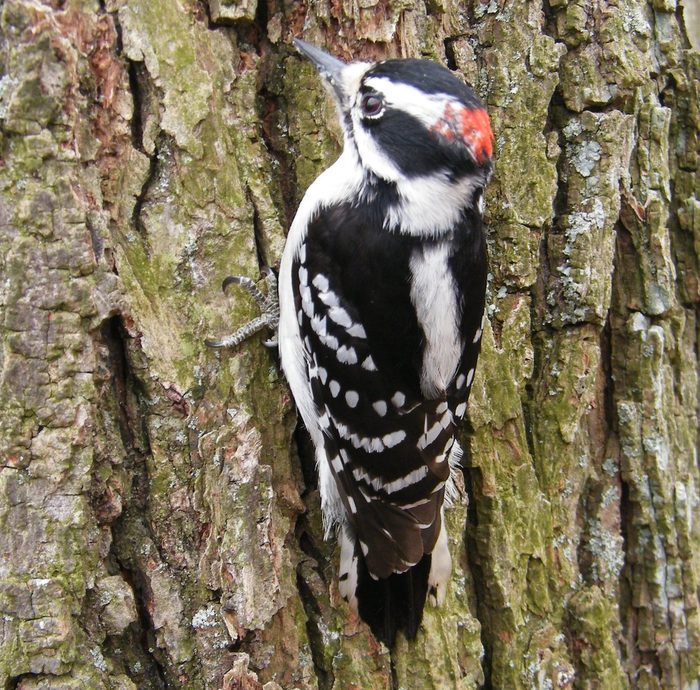
One of winter’s most underrated joys is watching through a kitchen window as a downy woodpecker flits from suet feeders to nearby trees. Affectionately called downies, these woodpeckers might easily be mistaken for a nuthatch clinging acrobatically to the side of a feeder, or a peppy chickadee, with its bold black-and-white coloring.
Look for a bird slightly smaller than a robin with a white belly and back, black wings with white spots, and white facial stripes against a mostly black head. Near the Pacific coast, some birds are muddled-looking—their bright bellies have tan accents, and they have fewer white dots spotting their wings.
Downies measure 6-1/2 inches long with a wingspan of 12 inches. Hairy woodpeckers have the same coloration but are larger than downies. A practiced eye can tell them apart by the size of their beaks, too. The hairy’s beak is almost as long as its head, while downies’ beaks are shorter, comparatively.
Check out more woodpecker species birders should know.
Male and Female Downy Woodpeckers

Males and females can be told apart by a red marking on the back of the male’s head. Downy woodpeckers form pairs very early in the season. Courtship begins toward the end of winter. Both sexes drum on trees (and sometimes unfortunate chimneys) to claim their territory and indicate they’re ready to mate. Listen for this rhythmic sound as early as January.
They also call out to each other in whinnying, high-pitched notes that are accented by excited piks. Once paired, the partners dig out a cavity in a dead tree for their nest.
Learn all about red bellied woodpeckers.
What Do Downy Woodpeckers Eat?

Their diet mainly consists of insects, caterpillars, berries and nuts. Downies snack on insects that harm trees, like bark beetles and apple borers—so be thankful if you see one hopping on the branches in your yard.
They are drawn to feeders in many locations, both developed and rural. Hang their favorite treats, suet and peanut butter, to attract them.
Kimberly Sullivan, associate professor of biology at Utah State University, suggests getting suet scraps from the butcher and hanging them in a mesh bag, along with traditional cage feeders. In warmer months when suet spoils easily, black oil sunflower seeds, millet and peanuts are suitable meals.
Like most woodpeckers, downies use their exceptional long tongues to scavenge. “The very bristly tip of their tongues, almost like a bottle brush, impales and holds onto larvae,” says Kimberly.
Downies’ small size also gives them another advantage over their fellow woodpeckers. They are adept at climbing up large tree trunks and branches, but they also glean bugs and grubs from weeds, grasses and thin twigs that can support their 1-ounce frames.
Mixed Flock Behavior
In winter, downies are more social, teaming up with kinglets, chickadees and nuthatches to maximize their foraging efforts. “When a mixed flock comes into their territory, they usually join it,” Kimberly says.
Chickadees are the sentinels of the group and are usually the first to call out a nearby predator. This dynamic allows downies to spend more time digging in through the tree bark and less time on high alert.
Downy Woodpecker Call
Listen to the downy woodpecker’s call. This species makes a short and flat “pik” sound.
Bird songs provided by the Cornell Lab of Ornithology.
Learn about acorn woodpeckers: the ultimate stockpilers.
Nest and Eggs

Downies excavate or reuse a cavity in a dead tree or use a woodpecker nesting box. The female lays four to five white eggs.
“I feed downies year-round! There’s nothing cuter than baby woodpeckers learning to come to the feeder in spring,” says Boni Trombetta of West Chester, Pennsylvania.
Meet the red headed woodpecker: redheads of the bird world.
Downy Woodpecker Range Map and Habitat
Downies reside in most of the United States and Canada, with the exception of the far north and the driest zones in the Southwest. These cheery checkered birds have expanded their ranges in the last few years, despite a changing, more urban, environment. You might see them in any open wooded area, including parks and backyards.
“There has been an expansion,” says Kimberly. “They’ve done quite well in suburban areas because they visit bird feeders and don’t mind open areas.”
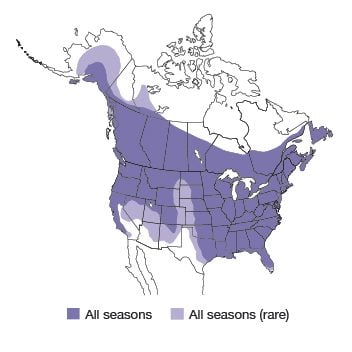
Range maps provided by Kaufman Field Guides, the official field guide of Birds & Blooms.
About the Expert
Kimberly Sullivan is an ornithologist and associate professor of biology at Utah State University. Kimberly received an award from The Animal Behavior Society for her studies of small birds.
Why Trust Us
For nearly 30 years, Birds & Blooms, a Trusted Media Brand, has been inspiring readers to have a lifelong love of birding, gardening and nature. We are the #1 bird and garden magazine in North America and a trusted online resource for over 15 million outdoor enthusiasts annually. Our library of thousands of informative articles and how-tos has been written by trusted journalists and fact-checked by bird and garden experts for accuracy. In addition to our staff of experienced gardeners and bird-watchers, we hire individuals who have years of education and hands-on experience with birding, bird feeding, gardening, butterflies, bugs and more. Learn more about Birds & Blooms, our field editor program, and our submission guidelines.
What Does a White-Throated Sparrow Look Like?

Clues to this bird’s identity include the small white throat patch, the yellow in front of the eye, and the rich reddish-brown on the shoulder and wing. Some white-throated sparrows have bold stripes of white and black on the head. Others have stripes of tan and dark brown. People used to think that the tan-striped birds were young ones. But that’s not necessarily true. About half of all adult white-throated sparrows, both males and females, are tan-striped for life.
White-throated sparrows measure 6-3/4 inches with a wingspan of 9 inches. When identifying sparrows, take note of face pattern, any streaking on the belly, and habitat.
Next, learn how to identify and attract chipping sparrows.
White-Throated Sparrow Song
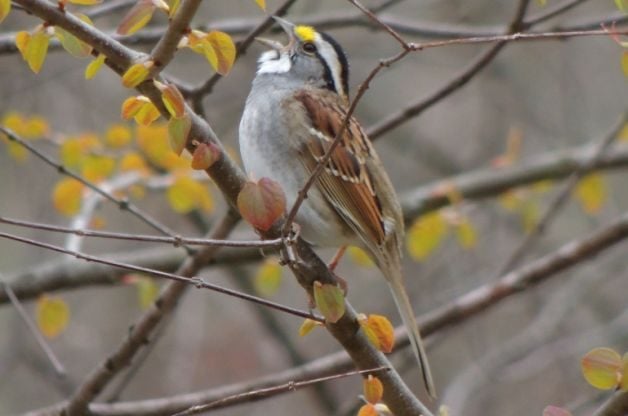
While some birders hear the white throated sparrow calling Oh sweet Canada Canada Canada, others think it sounds more like Old Sam Peabody Peabody Peabody.
Bird songs provided by the Cornell Lab of Ornithology.
Royal bird: Meet the white-crowned sparrow.
Nest and Eggs
This sparrow builds a nest from fine materials on or near the ground; the female lays up to six blue to green eggs with reddish-brown specks.
Discover fascinating sparrow facts you should know.
Food and Diet
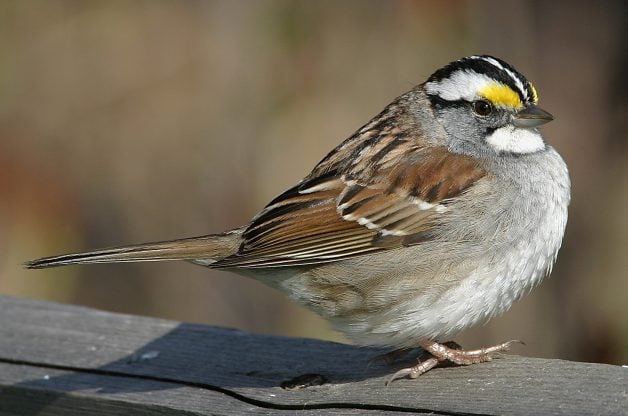
Attract these birds by offering nyjer thistle seed, cracked corn, white proso millet, black oil sunflower seed and hulled sunflower seed in your bird feeders. They also eat weed seeds, fruits, buds and insects.
Learn how to feed and attract native sparrows.
White-Throated Sparrow Range Map and Habitat

These birds are common in gardens, residential areas, woodlands and clearings. White-throated sparrows are commonly seen in the East, but are much less common in the West.
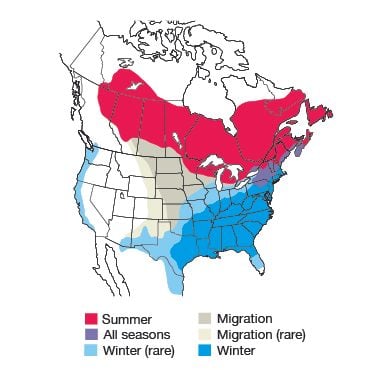
Range maps provided by Kaufman Field Guides, the official field guide of Birds & Blooms.
Next, discover cool facts about dark-eyed juncos.

This Halloween, dress up your front porch with festive fall containers. One of my favorites is the pumpkin bouquet planter. Nothing announces the arrival of fall more than a pumpkin filled with flowers.
When you start to pull out the seasonal decorations for your home and yard, add some plants to the mix. Consider planting flowers like chrysanthemums and pansies, or ornamental vegetables like kale and cabbage in a pumpkin planter.
Pair your pumpkin planter with with gourds grown in the garden, rustic corn stalks and straw bales fresh from the farmers market, or your favorite spooky Halloween décor. Bold warm colors like reds and yellows, or cool tones like purples and blues, will brighten up your yard throughout the fall.

How to Fill a Pumpkin With Flowers
- When visiting the pumpkin patch with your kids or grandkids, grab a medium- or large-size pumpkin. Choose a pumpkin with a sturdy base to create a stable container that will dress up the front stoop. You could also use an artificial pumpkin.
- Cut a hole in the top wide enough to snuggly insert a plant pot — about 6 inches in diameter.
- Scoop out the pumpkin seeds and pulp for a smooth surface, just as you would a jack-o-lantern. (You can feed the seeds to the birds!)
- Take a 6-inch round pot of fall flowers (your choice on color preference) and place it inside the carved hole. If the pumpkin is large, use filler for the inside, such as empty plastic bottles, or plastic foam packing. The container lip should just clear the top of the pumpkin.
- You can also make your carved pumpkin cheerier by tucking an autumn bouquet into a vase that fits snugly inside the shell. Arrange flowers to hide the rim of the vase.
Learn how to make a super cute, no-carve owl pumpkin.

How to Make a Ghost Hanging Basket
If you have space for hanging baskets, you can also make a spooky ghost container to greet trick-or-treaters this year. Select a lush basket of white spreading and trailing pansies, petunias or other white flowers from the local gardening center. Add sunglasses or spooky eyes to the hanging container to create a ghoulish ghost, and hang on your front patio. The pansies will spill over the sides of the container, giving the impression of a ghost on the run when the breeze blows.
Next, if you have plastic pumpkin buckets, learn how to make a tipsy pumpkin planter.


